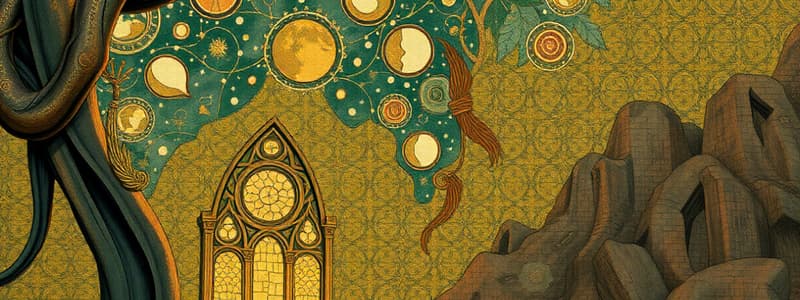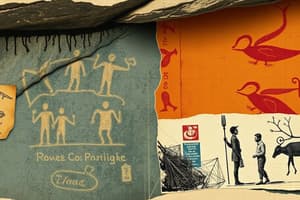Podcast
Questions and Answers
¿Cuál es una técnica utilizada en el estudio de artes rupestres?
¿Cuál es una técnica utilizada en el estudio de artes rupestres?
- Estadísticas avanzadas
- Fotografía y documentación (correct)
- Ciencia forense
- Química analítica
Qué técnica se utiliza para crear relieves en las superficies rocosas?
Qué técnica se utiliza para crear relieves en las superficies rocosas?
- Pintura al óleo
- Grabado (correct)
- Técnicas de soplado
- Escultura en mármol
Qué aspecto se analiza para interpretar la simbología en las artes rupestres?
Qué aspecto se analiza para interpretar la simbología en las artes rupestres?
- Materiales utilizados
- Motivos y figuras (correct)
- Tamaño de la roca
- Ubicación geográfica
¿Cuál es una medida de conservación importante para los sitios de artes rupestres?
¿Cuál es una medida de conservación importante para los sitios de artes rupestres?
Qué se busca en la comparación con otras culturas al estudiar artes rupestres?
Qué se busca en la comparación con otras culturas al estudiar artes rupestres?
What period is primarily associated with rock art?
What period is primarily associated with rock art?
Which theory suggests that rock art served as a visual language among human groups?
Which theory suggests that rock art served as a visual language among human groups?
What function might rock art have served beyond artistic expression?
What function might rock art have served beyond artistic expression?
Which theory posits that rock art could represent deities or spiritual beliefs?
Which theory posits that rock art could represent deities or spiritual beliefs?
Which location is NOT significantly known for rock art?
Which location is NOT significantly known for rock art?
Flashcards are hidden until you start studying
Study Notes
Artes Rupestres
Respuesta con Procedimiento
-
Definición de Artes Rupestres:
- Se refiere a las manifestaciones artísticas realizadas sobre superficies rocosas, incluyendo pinturas, grabados y petroglifos.
-
Métodos de estudio:
- Observación directa:
- Inspección física de los sitios para documentar características visuales y locación.
- Fotografía y documentación:
- Uso de cámaras para capturar imágenes en alta resolución, facilitando el análisis posterior.
- Dibujo y calco:
- Realización de reproducciones para estudiar los detalles y técnicas utilizadas.
- Observación directa:
-
Análisis de técnicas:
- Pintura:
- Uso de pigmentos naturales, aplicados mediante dedos, pinceles o técnicas de soplado.
- Grabado:
- Técnicas de incisión o rasguño sobre la roca para crear relieves.
- Pintura:
-
Contextualización cultural:
- Interpretación simbólica:
- Análisis de los motivos y figuras, buscando significados asociados a rituales o creencias.
- Comparación con otras culturas:
- Estudio de similitudes y diferencias con expresiones artísticas de otros grupos humanos.
- Interpretación simbólica:
-
Conservación y protección:
- Medidas de preservación:
- Iniciativas para proteger los sitios, considerando el impacto del turismo y la erosión natural.
- Documentación digital:
- Uso de tecnologías como escaneos 3D para preservar el estado de los sitios rupestres.
- Medidas de preservación:
-
Aplicaciones contemporáneas:
- Investigación arqueológica:
- Contribución al entendimiento de sociedades prehistóricas.
- Educación y sensibilización:
- Programas para informar sobre la importancia cultural y patrimonial de las artes rupestres.
- Investigación arqueológica:
Rock Art
- Rock art = Art made on rock surfaces like paintings, engravings, and petroglyphs.
- Studying rock art = Methods for learning about rock art
- Look closely = See the art in person, note details, and understand the location.
- Camera = Take high-resolution pictures for analysis later.
- Draw/trace = Copy the art to study details and techniques.
- Making rock art = How rock art was created:
- Painting = Use natural pigments, apply with fingers, brushes, or blowing.
- Engraving = Carve or scratch into rock to make designs.
- What it means = Understanding the rock art:
- Symbols = Study designs and figures to find meanings connected to rituals or beliefs.
- Compare = See how rock art is similar or different to other cultures' art.
- Protecting rock art = Keeping the sites safe:
- Preservation = Measures to safeguard sites from tourism, erosion, and damage.
- Digital records = 3D scans to preserve the condition of rock art sites.
- Rock art today = Modern uses:
- Archaeology = Helps understand prehistoric societies.
- Education = Share the cultural and historical importance of rock art with everyone.
Rock Art: A Peek into Prehistory
- Rock Art: Hands up! clap This is old-timey art on rock walls, like paintings and carvings.
- Location: Found all over the world point to different areas, like Europe, Africa, and the Americas.
- Time: People made rock art during the Stone Age make a stone shape with your hands, especially the Old Stone Age and the Middle Stone Age.
- Who made it: Groups of people who moved around motion of walking and lived off the land mimic hunting and gathering.
Theories about the meaning of rock art
- Magic Theory: Maybe they used rock art for ceremonies mimic a ceremony like chanting so they could hunt well!
- Communication Theory: Maybe they talked to each other with these pictures point to different areas of a wall.
- Social Theory: Maybe these pictures tell us about how people lived mimic different social roles and what they believed in.
- Beauty Theory: Maybe they just liked making pretty pictures! make an artistic gesture.
- Religion Theory: Maybe these pictures show their gods, spiritual beliefs, or special experiences! mimic praying or thinking.
- History Theory: Maybe these pictures are like a photo album, showing the animals and plants they saw mimic taking a photo.
- All of the Above Theory: Maybe there are lots of reasons why they made rock art! point to different areas to show all possibilities.
Studying That Suits You
Use AI to generate personalized quizzes and flashcards to suit your learning preferences.





